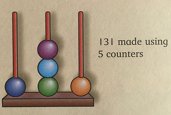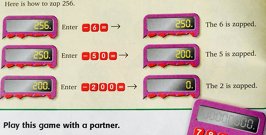Make a number
Organisation: groupsPupils choose five pieces of base 10 apparatus and make a three-digit number. They choose another five pieces and make a different number. Repeat this five times. They record their numbers in order, such as 122, 212, 221, or 203, 230, 302, …
Make a hundred
Organisation: groupsPupils roll two dice, add the scores and make the score in base 10 apparatus. They change units for tens until they reach a hundred. The first to reach a hundred wins.
Break a hundred can be played with the same apparatus as Make a hundred. Here pupils remove their score from a hundred, exchanging tens for ones. The first to reach zero wins.
Make five hundred, Break five hundred, Make a thousand and Break a thousand can be played in the same way.
My number is …
Organisation: groupsA pupil thinks of a number. The others take turns to ask a question about it which can only be answered yes or no.
Is your number between 200 and 500? Yes.
Is your number between 200 and 300? No.
Is your number between 300 and 400? Yes.
Is it odd? Yes.
This continues until someone guesses the number then that pupil ‘thinks of a number’.
Place value game
Organisation: pairsPairs use base 10 apparatus, shuffled Digit cards 0-9 placed face down and strips of 10 squares. They each take three cards, make the largest number and show it with the apparatus. The pupil with the larger number colours a square on their strip. The first to colour ten squares wins. The activity can be repeated for making the smallest number.
Ordering numbers
Organisation: groups, pairs, individualsUsing a shuffled pack of Digit cards 0-9, pupils take the top three cards and make the largest number they can, then return cards to the pack and re-shuffle. They repeat this for five turns then order their numbers. This can be repeated for making the smallest number they can.
Reverse the digits
Organisation: pairsPupils take turns to enter a two-digit number on their calculator. The other decides what to enter in order to reverse the digits, such as changing 35 to 53.
Calculator numbers
Organisation: pairsPupils take turns to enter a two-digit number on their calculator. The other decides what to add or subtract to round this to the nearest ten, then records the key presses.
3 6 + 4 = 4 0
This activity can be repeated for hundreds such as changing 337 to 340 or to the next hundred.
Digits game
Organisation: whole classShuffle one set of digit cards 0-9, or place them in a small bucket and shake them thoroughly.
Each pupil will need to draw three boxes next to each other to write digits in.
Choose a card at random and show it to the pupils. They choose in which of the three boxes to write the digit. Continue choosing digit cards at random. The aim is for pupils to place digits in the boxes to try to match a given number, such as:
Make the largest number.
Make the smallest number.
Make the number nearest to 500.
Discuss which positions would have been the best for the selected digits.
Get in order
Organisation: whole classUse ten pieces of card, about playing card size, on which are written the digits 0-9. Each pupil will need a game sheet like the one below.
Shuffle the digit cards, or place them in a small bucket and shake them thoroughly.
Choose a card at random and show it to the pupils.
They choose in which of the nine boxes to write the digit. Continue choosing digits cards at random.
The aim is for pupils to place digits in the boxes so that the number sentence is true. For each game, decide whether to return the selected digit card so that it has the chance of being picked again. This should change the strategy which pupils might employ.
Draw a 3-prong abacus and place 5 counters on it.
Move your counters to make different numbers. Write them in a list.
Look at the numbers in your list.
Can you find pairs of numbers that have a difference of 9?
Which pair of numbers has the largest difference?
... you used 6 counters each time?
... the abacus had 4 spikes?
Move your counters to make different numbers. Write them in a list.
Look at the numbers in your list.
Can you find pairs of numbers that have a difference of 9?
Which pair of numbers has the largest difference?
Which pair of numbers has the smallest difference?
What if...... you used 6 counters each time?
... the abacus had 4 spikes?
Try this with a partner, you will each need a calculator.
Each of you enter a different hundreds number (256)
Take turns to zap a digit from your partner's display ( - 6 = 250)
Digits can be zapped in any order and keep going until you get to zero.
Start with larger numbers. Can you zap numbers by adding?
Each of you enter a different hundreds number (256)
Take turns to zap a digit from your partner's display ( - 6 = 250)
Digits can be zapped in any order and keep going until you get to zero.
Start with larger numbers. Can you zap numbers by adding?
















